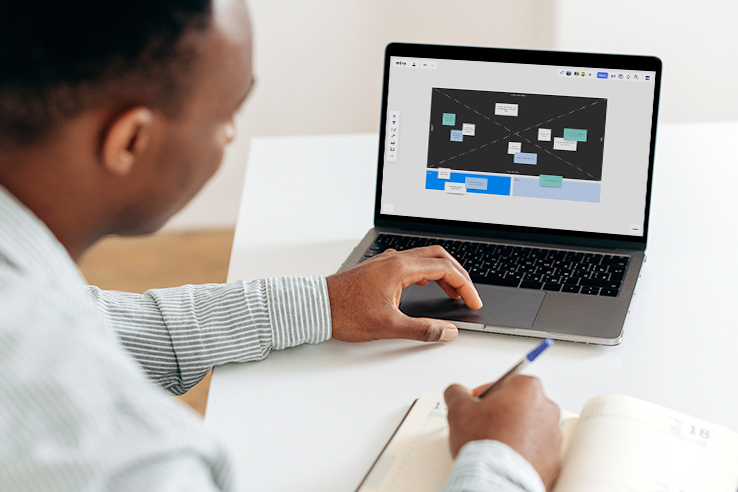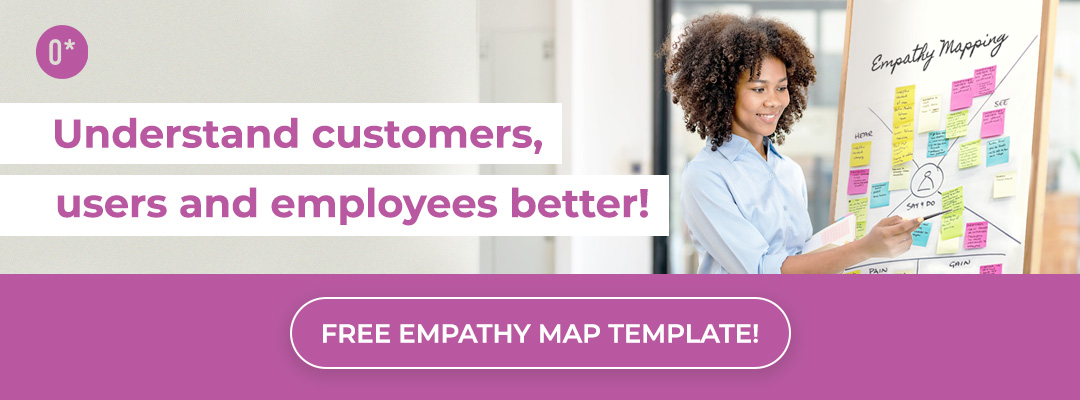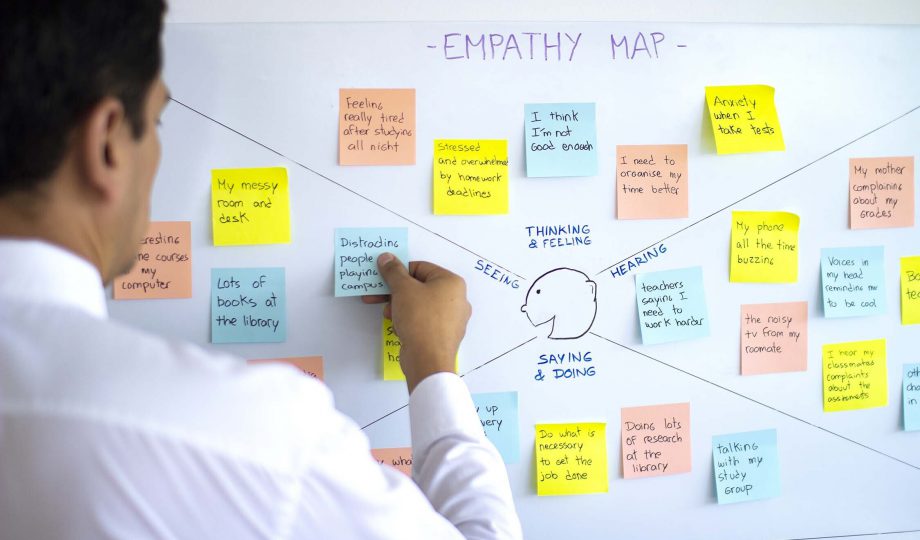
Over here at Outwitly, we’ve been talking about empathy maps for a long time! They’re amazing tools that designers, UX researchers, and stakeholders can use to develop an empathetic understanding of the people they are designing products and services for. Because we can’t read minds (if only!), empathy maps help to portray what is really going on in the heads and in the hearts of those we are designing for. They’re incredibly useful tools for helping designers, team members, and stakeholders empathize with people like users and customers.
Today’s post will break empathy maps down into a ton of detail, so you and your team know exactly how to conduct a virtual empathy mapping workshop! We’ll dive into:
- 5 Tips for Planning a Virtual Empathy Map Workshop
- 9 Tips for Running an Effective Empathy Mapping Workshop
- Accessibility and Empathy Mapping
Let’s get started!
5 Tips for Planning a Virtual Empathy Map Workshop
Since 2020, the way many of us work on a daily basis has moved online. This means the traditional in-person workshops we once knew, featuring flip charts, sticky notes, and face-to-face connection, have been adapted to suit the virtual workplace. Luckily, we’ve been at the forefront of this transition, and we have an easy solution for bringing empathy mapping workshops into the virtual world!
Here are our best tips for preparing for and conducting virtual empathy mapping exercises:
Note: The planning process isn’t always linear! We recommend tackling whichever step makes the most sense for your specific situation first, or delegating multiple tasks to be completed simultaneously. Maybe you want to figure out your co-host situation first, start creating your whiteboard second, and send out a detailed invitation last!
1. Time chunk
Time management is critical for facilitating remote workshops. Once you have an idea of many people you’ll be inviting, plan out each key discussion you want to cover and how long it should take. Consider setting side:
-
- 5 minutes to allow people to join the call.
- 2 minutes to introduce yourself.
- 5–10 mins for an icebreaker (depending on group dynamics).
- 5 minutes to introduce empathy mapping.
- 30 minutes for conducting the empathy mapping.
- 5 minutes for each group to present.
- 10 minutes for a bio and sensory break.
- 5 minutes to summarize, discuss next steps and to thank the attendees.
2. Create your virtual whiteboard
Which tool is the best? We recommend Miro, MURAL, Figjam or the whiteboard that’s built into the software you already use every day (like Microsoft Teams!). Some whiteboards allow you to hide frames you create until you’re ready to reveal them. If you’d like to send participants the link to your whiteboard before the workshop, you can do so while hiding the empathy mapping activity itself until the session starts!
-
- Whiteboard must-haves:
- Your schedule so others understand what to expect from the meeting.
- Goals for the session.
- An introduction to empathy mapping.
- Space on the board for each group to work on their empathy map in the session.
- Great to include, but optional:
- Examples of empathy maps, or previous empathy maps you’ve created.
- Any user research materials you want participants to review prior to the session.
- Virtual stickies for people to grab, and write down their ideas. (We find these can be helpful for those who aren’t used to creating things in the tool themselves.)
- Whiteboard must-haves:
3. Make the most of your invitation
-
- Introduce yourself and outline purpose of the session in your event invite.
- Attach a calendar invite for participants to accept.
- Introduce the whiteboarding software you’ll be using, in case there are participants who haven’t used it before. This is a great way to save time answering questions about how whiteboard software works at the beginning of workshops! Link a how-to video to help everyone get up to speed before the meeting.
- We also recommend asking your attendees to join the meeting in a place where they feel comfortable having their audio on for discussion, and their camera on if you feel it’s necessary.
- If you have any research from a repository, interviews, video recordings of your users, or just a few insights, you might want to share these, for the benefit of anyone who is less familiar your users.
- Ask attendees to share any relevant information about accessibility requirements so you can educate yourself about their reality and create an inclusive environment!
4. Invite a co-host
Whether you are a consultant or a full-time staff member, consider inviting someone to help you out! Co-hosts can help take the pressure off of creating a welcoming environment, or remedying any technical issues that might come up (e.g. muting that person whose dog starts barking). Be sure to set expectations for what you need help with, and share your meeting schedule with them to ensure they understand where they fit in.
5. Set up your video tool
-
- Configure permissions: Make sure you give your tool permission to access audio, video and screen sharing on your device. Ensure that as the host or co-host, you have permission to configure what you need.
- Test breakout rooms: If there are more than 4–5 people in your session, test how breakout rooms work with your software so you can feel confident setting them up for your participants in the moment.
- Determine how screen sharing works! Every software is a little bit different. Test this out to make sure you’re confident that you won’t share the wrong tab. Friendly tip: pause any notifications from your email, slack, or any other tools you have that might share messages to your desktop when you’re presenting. Trust us… this might help prevent an awkward situation!
- Test your audio and video: Make sure everything is working correctly before the big session! Consider configuring a virtual background that highlights your personality. We personally miss people joining calls with “The Office” themed backgrounds, and we highly recommend bringing that back.
- Make sure your tool is workable for your participants with accessibility requirements. If you can’t figure it out yourself, you can always ask them to test the tool ahead of time!
Once these planning steps are complete, you’ll feel cool and composed heading into the empathy mapping session!
Watch Outwitly’s CEO Sara Fortier, who was featured on CTV News, as she explores empathy mapping and how it works in both professional and personal contexts.
9 Tips for Running an Effective Empathy Mapping Workshop
As we mentioned, conducting empathy mapping workshops virtually is quite different compared to traditional in-person sessions! The goals and objectives of the sessions are the same, but the delivery and the way of connecting are different. Fear not! We’ve broken the workshop process down into eight steps for you to replicate!
1. Log in 10 minutes before the session starts.
If you have a co-host, make sure they show up early with you. The last thing you want is technical difficulty or to be rushing to a meeting you’re facilitating. Share your screen, open your schedule, and take a minute to feel confident and prepared. Welcome those who want to join the meeting early. (Yes, people do that.)
2. Introduce yourself.
It’s easy to forget this part when you’re nervous, with a group of strangers, or when there’s just a lot going on. After welcoming everyone to the session, discuss your credentials, how and why you got into this type of work and what you have planned for the day.
3. Ensure the group is comfortable with each other.
Group activities like empathy mapping require people to express their ideas, which can often feel uncomfortable for those who don’t know us very well, or those who are worried about saying something “wrong” in front of their boss. To help mitigate this and assist group members in adopting a beginner’s mindset, we recommend you set the mood and build some empathy within the group by using an icebreaker. There are many awesome icebreaker activities on sites like Gamestorming, or in the community templates of Miro or Figjam. If you need a quick and heartwarming idea, we recommend the following prompt:
- Each person can share their name, job title and team, as well as something they’re grateful for or looking forward to. Lead the group by going first, choosing the next in line, and having that next person do the same until everyone has gone. Keep track of each person’s turn because it’s easy to accidentally leave people out.
4. Introduce empathy mapping, and have everyone start solo.
- Open your whiteboard and show them what you’ve prepared including an example if you think it will help them.
- Have teams write down their ideas on their virtual sticky notes, and move them onto the empathy map in the appropriate sections.
- Before you ask your participants to start brainstorming, encourage them to write down their ideas individually without looking at the other group members’ ideas. This helps to avoid groupthink!
- Ask them first to brainstorm what the persona would see, hear, think, and do in their situation while trying to complete their goal or task (which you have already defined for each group), and then brainstorm pains and gains afterwards. Remember to adapt your questions to contain inclusive language!
5. Break the group up into teams of 4–5 people.
- Have each team be responsible for one persona. You will need to roughly define these teams in the planning phase, and you may want to determine which member will present their team’s persona ahead of time.
- If you’re a group of 4–5 people or less, encourage your participants to start solo by playing some music to help them focus, and to prevent them from talking during this time. Stop the music when it’s time to share, and prompt the group with follow-up questions when necessary. Take notes on any themes you observe to share with the group in your summary. If your whiteboarding tool doesn’t have a playlist, try out our favourite playlist.
If your group has more than 4–5 people, send them to breakout rooms with the following instructions:
6. Prompt them to brainstorm what the persona would see, hear, think, and do.
Tell them how much time they have to do so. If you can set up a timer for them, do it! Proactively check in on those who have disclosed their accessibility requirements to ensure they can follow along with the group and that they feel included.
7. Prompt them to move on to pains and gains.
8. Close the breakout rooms.
Now that everyone is back in the same conversation, your goal is to keep the energy going, as people start to fade and disconnect! Introduce your bio and sensory break, and when everyone returns ask one person from each breakout group to summarize and present their empathy map. Ask them to identify 2–3 key ideas per section and present them to the group. Thank each person for speaking and then pick the next group to present. Let them know they have five minutes, and if you’re still sharing your screen, share a timer so they don’t go over.
9. Wrap up by thanking your group and sharing what will come next.
Send out the empathy maps for others to review, and once they’ve been looked over, use this information to build or refine your personas. To ensure you improve continuously as a facilitator we recommend sending out a survey or reaching out to your participants for feedback. It’s especially important to learn from your participants who disclosed their accessibility requirements so you can improve your ability to include others in the future!
Virtual Workshopping and Accessibility
You’ll notice that throughout the article, we gave you some tips on how to make your virtual workshop more accessible and inclusive for participants with disabilities. As a facilitator of a workshop about empathy, you need to reflect on the empathy you have for both your user types: those who are the subjects of your empathy maps, and those who are creating the maps in your workshop session.
Empathizing with your participants
- Adapting your empathy mapping workshop to the virtual world provides you and your participants with many assistive tools you wouldn’t otherwise have in physical workshops, like screen readers, closed captioning services, and speech-to-text services!
- In addition to the tips we’ve provided above, work with your participants who have accessibility requirements to leverage these assistive tools before your workshop, to ensure everything’s functioning adequately. Remember, a facilitator’s awareness and empathy for their participants can be as effective as technology.
Empathizing with your users
- It’s crucial to ensure that the language of your empathy map is relevant to your users. The article, “Your Empathy Lacks Empathy” by Dave Hoffer discusses the importance of creating variations of frameworks to resonate with users who have physical and cognitive disabilities.
- Some great examples Hoffer provides:
- If your user is visually impaired, “What do they perceive?” might be a more appropriate question than “What do they see?”
- If your user is hearing impaired, “How do they receive information?” could be a better question than “What do they hear?”
As you prepare your virtual whiteboard environment for the mapping session, make sure you’re adapting the questions you’ll ask in each map section to best reflect the life experience of your users. It’s important to approach this with sensitivity, and consideration of their specific contexts. We encourage you to have variations of your frameworks so you can uphold inclusivity in different situations.
We know that was a lot of info to take in! Between prepping the session and conducting it, you’re sure to have your hands full. Feel free to bookmark this tab and revisit it when you’re planning your next empathy mapping session. We have no doubt that if you follow these steps, you’ll lead your clients and team members like a pro.




